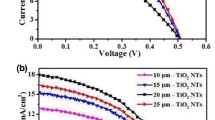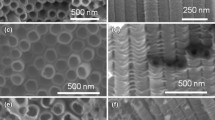Abstract
The well-ordered TiO2 nanotube arrays with controlled aspect ratio are fabricated via potentiostatic anodization. The aspect ratio of TiO2 nanotube array can be tuned conveniently by changing the water content in electrolyte and anodization time. The formation of well-ordered TiO2 nanotube array is good for the photogenerated electron transfer. So, the well-ordered TiO2 nanotube array photoelectrodes have been used to fabricate dye-sensitized solar cells (DSSCs). It is found that, with the optimum nanotube length and aspect ratio, DSSCs with TiO2 nanotube array photoelectrodes show better photoelectric conversion efficiency (2.60%) than that with TiO2 nanoparticles on Ti foil photoelectrode. It is elucidated by the interfacial electron transport of DSSCs, which are characterized quantitatively, using the electrochemical impedance spectra. The DSSC with optimal nanotube length and aspect ratio displays the fastest interfacial electron transfer and longer electron lifetime.









Similar content being viewed by others
REFERENCES
B. O’Regan and M. Grätzel: A low-cost, high-efficiency solar cell based on dye-sensitized colloidal TiO2 films. Nature 353, 737 (1991).
U. Bach, D. Lupo, P. Comte, J-E. Moser, F. Weissortel, J. Salbeck, H. Spreitzer, and M. Grätzel: Solid-state dye-sensitized mesoporous TiO2 solar cells with high photon-to-electron conversion efficiencies. Nature 395, 583 (1998).
M. Grätzel: Recent advances in sensitized mesoscopic solar cells. Acc. Chem. Res. 42, 1788 (2009).
A. Yella, H-W. Lee, H-N. Tsao, C. Yi, A-K. Chandiran, M-K. Nazeeruddin, E-W. Diau, C-Y. Yeh, S-M. Zakeeruddin, and M. Grätzel: Porphyrin-sensitized solar cells with cobalt (II/III)–based redox electrolyte exceed 12 percent efficiency. Science 334, 629 (2011).
Y-J. Kim, M-H. Lee, H-J. Kim, G. Lim, Y-S. Choi, N. Park, K. Kim, and W-I. Lee: Formation of highly efficient dye-sensitized solar cells by hierarchical pore generation with nanoporous TiO2 spheres. Adv. Mater. 21, 3668 (2009).
Q-F. Zhang, K. Park, J-T. Xi, D. Myers, and G-Z. Cao: Recent progress in dye-sensitized solar cells using nanocrystallite aggregates. Adv. Energy Mater. 1, 988 (2011).
A. Mishra, M-K-R. Fischer, and P. Bäuerle: Metal-free organic dyes for dye-sensitized solar cells: From structure: Property relationships to design rules. Angew. Chem. Int. Ed. 48, 2474 (2009).
G-L. Shang, J-H. Wu, M-L. Huang, J-M. Lin, Z. Lan, Y-F. Huang, and L-Q. Fan: Facile synthesis of mesoporous tin oxide spheres and their applications in dye-sensitized solar cells. J. Phys. Chem. C 116, 20140 (2012).
B. O’Regan, K. Bakker, J. Kroeze, H. Smit, P. Sommeling, and J-R. Durrant: Measuring charge transport from transient photovoltage rise times. A new tool to investigate electron transport in nanoparticle films. J. Phys. Chem. B 110, 17155 (2006).
S. Sodergren, A. Hagfeldt, J. Olsson, and S-E. Lindquist: Theoretical models for the action spectrum and the current-voltage characteristics of microporous semiconductor films in photoelectrochemical cells. J. Phys. Chem. 98, 5552 (1994).
K. Pan, Y. Dong, W. Zhou, G. Wang, Q. Pan, Y. Yuan, X. Miao, and G. Tian: TiO2-B nanobelt/anatase TiO2 nanoparticle heterophase nanostructure fabricated by layer-by-layer assembly for high-efficiency dye-sensitized solar cells. Electrochim. Acta 88, 263 (2013).
A. Martinson, M. Goes, F. Fabregat-Santiago, J. Bisquert, M. Pellin, and J. Hupp: Electron transport in dye-sensitized solar cells based on ZnO nanotubes: Evidence for highly efficient charge collection and exceptionally rapid dynamics. J. Phys. Chem. A 113, 4015 (2009).
L. Yang and W. Leung: Application of a bilayer TiO2 nanofiber photoanode for optimization of dye-sensitized solar cells. Adv. Mater. 23, 4559 (2011).
Z.Y. Liu and M. Misra: Dye-sensitized photovoltaic wires using highly ordered TiO2 nanotube arrays. ACS Nano 4, 2196 (2010).
G. Zhang, K. Pan, W. Zhou, Y. Qu, Q. Pan, B. Jiang, G. Tian, G. Wang, Y. Xie, Y. Dong, X. Miao, and C. Tian: Anatase TiO2 pillar–nanoparticle composite fabricated by layer-by-layer assembly for high-efficiency dye-sensitized solar cells. Dalton Trans. 41, 12683 (2012).
B. Tan and Y. Wu: Dye-sensitized solar cells based on anatase TiO2 nanoparticle/nanowire composites. J. Phys. Chem. B 110, 15932 (2006).
M. Yang, H. Jha, N. Liu, and P. Schmuki: Increased photocurrent response in Nb-doped TiO2 nanotubes. J. Mater. Chem. 21, 15205 (2011).
K. Zhu and A-J. Frank: Converting light to electrons in oriented nanotube arrays used in sensitized solar cells. MRS Bull. 36, 446 (2011).
J. Wang and Z-Q. Lin: Dye-sensitized TiO2 nanotube solar cells with markedly enhanced performance via rational surface engineering. Chem. Mater. 22, 579 (2010).
M. Yang, D. Kim, H. Jha, K. Lee, J. Paul, and P. Schmuki: Nb doping of TiO2 nanotubes for an enhanced efficiency of dye-sensitized solar cells. Chem. Commun. 47, 2032 (2011).
P-T. Hsiao, Y-J. Liou, and H. Teng: Electron transport patterns in TiO2 nanotube arrays based dye-sensitized solar cells under frontside and backside illuminations. J. Phys. Chem. C 115, 15018 (2011).
M. Paulose, K. Shankar, O-K. Varghese, G-K. Mor, B. Hardin, and C-A. Grimes: Backside illuminated dye-sensitized solar cells based on titania nanotube array electrodes. Nanotechnology 17, 1446 (2006).
M. Paulose, K. Shankar, O-K. Varghese, G-K. Mor, and C-A. Grimes: Application of highly-ordered TiO2 nanotube-arrays in heterojunction dye-sensitized solar cells. J. Phys. D: Appl. Phys. 39, 2498 (2006).
P. Roy, D. Kim, K. Lee, E. Spiecker, and P. Schmuki: TiO2 nanotubes and their application in dye-sensitized solar cells. Nanoscale 2, 45 (2010).
Z. Liu, X. Zhang, S. Nishimoto, M. Jin, D-A. Tryk, T. Murakami, and A. Fujishima: Highly ordered TiO2 nanotube arrays with controllable length for photoelectrocatalytic degradation of phenol. J. Phys. Chem. C 112, 253 (2008).
K. Shankar, G-K. Mor, A. Fitzgerald, and C-A. Grimes: Cation effect on the electrochemical formation of very high aspect ratio TiO2 nanotubes in formamide-water mixtures. J. Phys. Chem. C 111, 21 (2007).
L. Qi, Y. Ma, Q. Ouyang, Y. Zhang, L. Li, and Y. Chen: The controllable synthesis of chain-like TiO2 networks with multiwalled carbon nanotubes as templates and its application for dye-sensitized solar cells. J. Nanopart. Res. 14, 907 (2012).
G-K. Mor, K. Shankar, M. Paulose, O-K. Varghese, and C-A. Grimes: Enhanced photocleavage of water using titania nanotube arrays. Nano Lett. 5, 191 (2005).
K. Pan, Y-Z. Dong, C-G. Tian, W. Zhou, G-H. Tian, B-F. Zhao, and H-G. Fu: TiO2-B narrow nanobelt/TiO2 nanoparticle composite photoelectrode for dye-sensitized solar cells. Electrochim. Acta 54, 7350 (2009).
C. Longo, A-F. Nogueira, M-A. De Paoli, and H. Cachet: Solid-state and flexible dye-sensitized TiO2 solar cells: a study by electrochemical impedance spectroscopy. J. Phys. Chem. B 106, 5925 (2002).
ACKNOWLEDGMENTS
This work was supported by the National Natural Science Fund of China (Grant Nos. 51302047, 51072038, 51272050, and 61205113), the Program for New Century Excellent Talents in University (NECT-10-0049), the Outstanding Youth Fund of Heilongjiang Province (Grant No. JC201008), the 111 project (B13015) of Ministry Education of China to the Harbin Engineering University, and also the Fundamental Research Funds for the Central Universities of China for the financial support of this research.
Author information
Authors and Affiliations
Corresponding author
Rights and permissions
About this article
Cite this article
Qi, L., Yin, Z., Zhang, S. et al. The increased interface charge transfer in dye-sensitized solar cells based on well-ordered TiO2 nanotube arrays with different lengths. Journal of Materials Research 29, 745–752 (2014). https://doi.org/10.1557/jmr.2014.50
Received:
Accepted:
Published:
Issue Date:
DOI: https://doi.org/10.1557/jmr.2014.50




